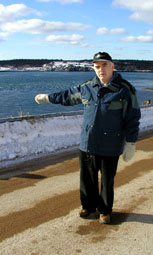
![]()
Volume 7, No. 1
Promoting Cooperation to Maintain and Enhance
Environmental Quality in the Gulf of Maine
|
||||||||||
|
|
|
|
|
|
|||||||
|
|
|
|
Browse the archive |
|
|
|
|
Editor’s Notes
On the road to a Bay of Fundy Discovery Centre
By Andi Rierden, Editor
The snows arrived early this winter, long before the ground froze. Storm followed storm, then the cold set in steady and hard. Five-foot drifts deposited along the driveways and roads rousing the plows through the night. The ponds on the uplands froze, as did streams of freshwater in the tidal river. Sheets of ice laminated the saltwater marsh. Then one Saturday closing in on February a miracle occurred. The skies opened wide and the temperature spiked at 38 F (4 C), with barely a breath of wind. I took advantage of the balmy conditions by driving down to Long Island (Nova Scotia, that is) to visit Roger Outhouse.
 |
| Roger Outhouse near proposed site for the Bay of Fundy Discovery Centre Photo: Andi Rierden |
It is a gigantic proposal for a community of under 500, but already residents, academic researchers, businesses and the province’s tourism and economic development agencies have given the project a big thumbs up. An independent concept plan and feasibility study also reinforces what Roger has known for years: that a center celebrating one of the world’s grandest natural wonders is a good, sound idea whose time has come. “We couldn’t have done this 20 years ago,” says Roger, a soft-spoken and contented man with thick dark eyebrows and luminous eyes. “Today, more people, from all over are aware of the ecological treasures of this place.”
Yet it is impossible to discuss the discovery center without mentioning another, far more controversial proposal, though not nearly as popular. Just down the road from Freeport, in Digby Neck, an aggregate exporting company has been issued provincial approval to construct and operate a basalt quarry in an area known as White’s Cove. The company’s plan is to ship the mined basalt to the United States by freighter to be used as construction material. The decision has spurred province-wide debate over allowing a company to extract natural resources for use elsewhere with little in return for local communities.
Fishermen and area residents (60 percent of whom signed a petition opposing the quarry), say explosives and repeated blasting will damage the fishery, foul their quality of life and introduce new perils to the Bay of Fundy’s endangered North Atlantic right whale population. This at a time when the federal government has authorized shipping lane changes between Nova Scotia and New Brunswick to protect right whales.
To dredge for docking facilities, the company still needs permission from the federal Department of Fisheries and the Department of Transportation.
Roger is among the quarry’s opponents. “Apart from the few jobs it would bring in,” he says, “there are so many unknowns. It seems like it will benefit only the company selling the basalt to the U.S. And it’s going completely opposite to the need to create ecologically sound opportunities with long-term benefits favored by most of the community.”
Despite his concerns about the quarry and its incompatibility with a discovery center, Roger says he prefers to leave the scientific debate over the mining project to others in the community working steadfastly on the issue. Instead, he and his committee are plowing ahead, well prepared for the hard work needed to see the Fundy center come to life.
The light is falling and the wind has kicked up. We take a short drive to a hilltop optioned as the construction site for the center. It overlooks Grand Passage across to Brier Island, a stunning view right out of a maritime storybook. Roger is talking about upwellings.
“I’ll tell you why this area is the perfect place for the center,” he says. He sweeps his arm across the snowy vista while explaining how the Bay’s tidal currents act as powerful engines, advancing over the undersea ledges here, creating tremendous turbulence. The currents pump volumes of nutrients and food to the surface, unleashing a smorgasbord of salts, diatoms, copepods and herring. “Then there’s this incredible feeding frenzy,” he says.
In come veils upon veils of sea birds, joined by whales lunging in their midst and gulping down hopper-loads of feed. “I’ve even seen squid tentacles come to the surface,” Rogers continues. “What we witness right here is the ultimate display of the marine food chain in action.”
The discovery center plan also calls for an exhibit on volcanism that will show how the flow of lava formed the distinct columns of basalt at the end of the Triassic era, transforming the land and sea. As an added inducement for visitors, the plan incorporates satellite exhibits at surrounding salt marshes and mudflats, two viewing stations to be sited on Brier Island, a whale watching station and a bird-watching station.
The next step, Roger says, is to hire a full-time marketing professional, find sponsors and begin the search for funding. “We already have many, many people who are offering to volunteer,” Roger tells me as I drop him back at his house. “I’m very optimistic.”
The great oceanographer and conservationist Jacques Cousteau once said, “What we human beings are all living now, whether we are volunteers or not, is an extraordinary, but exceptionally dangerous adventure. And we have a very small number of years left to fail or to succeed in providing a sustainable future to our species.”
In a small community in southwestern Nova Scotia, Roger Outhouse and a group of devoted citizens are doing their best to create that successful, sustainable future.